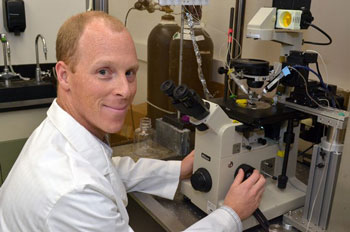
David Auerbach, senior instructor in medicine,
says his KL2 award has "opened many doors for me."
David Auerbach's interest in pursuing a scientific career began during a hockey game his first year of college, when a teammate — who turned out to be a chief medical examiner — asked Auerbach if he would like to observe a case.
Now Auerbach's career is taking a major step forward with a two-yearKL2 Mentored Career Development Program award from the University's Clinical and Translational Science Institute.
"It has opened up many doors for me," says Auerbach, including lead authorship of a recent paper in Neurology.
Auerbach, a senior instructor in the Department of Medicine/Aab Cardiovascular Research Institute, is taking a multisystem approach to understanding the mechanisms that cause electrical disturbances in both the hearts and brains of patients with genetic ion channel diseases. Ion channels, located in the plasma membrane of cells, are narrow tunnels that open and close at precise times to allow the flow of ions into or out of the cell, thus shaping the electrical activity in the heart and brain.
As a postdoc working with Lori Isom, a professor at the University of Michigan, Auerbach demonstrated that people with severe genetic forms of epilepsy were at a higher risk not only of electrical disturbances in the brain, resulting in seizures, but also of electrical disturbances in the heart, causing arrhythmias.
In order to establish an independent line of research, Auerbach decided to approach the problem in reverse: are people with long QT syndrome — a classically studied genetic cardiac disease that causes arrhythmias — also at an increased risk of seizures?
He came to Rochester in 2014 specifically because of its research strengths in this area, including the opportunity to work with such experts as Arthur Moss, the Bradford Berk Distinguished Professor of Medicine; Robert Dirksen, the Lewis Pratt Ross Professor and chair of pharmacology and physiology; and Charles Lowenstein, chief of cardiology and director of the Aab Cardiovascular Research Institute.